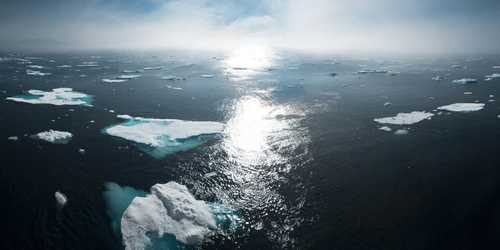
What is geoengineering and how scared should we be?
Climate engineering (also known as geoengineering) is a broad term which encompasses the removal of carbon dioxide from the atmosphere and the modification of solar radiation. Other processes – such as glacier stabilization, ocean liming, and the iron fertilization of oceans – may also be placed under the umbrella of this term. All of these technologies would “manipulate the environment [to] partially offset some of the impacts of climate change”.
Depending on your tolerance for techno-optimism, the notion that we – an overweening yet intensely fallible species with a catastrophic record of planetary custodianship – might deploy untested technologies on a planetary scale could ruin your sleep indefinitely.
This technology sounds like the stuff of science fiction – an origin story for the world of Mad Max, perhaps? Even prominent climate economist Gernot Wagner – who has worked on geoengineering at the Environmental Defense Fund, helped to launch Harvard’s Solar Geoengineering Research Program, and written a book on the subject – considers the idea “nuts”. And he has also noted that, if carried out, solar geoengineering is likely to be “fast, cheap and highly imperfect”. It’s all too believable that enthusiasm for the first two descriptors could drown out concerns about the third.

But does the very concept of these radical, large-scale schemes act as a Get Out of Jail Free card enabling us to avoid making either day-to-day changes to our lifestyles or systemic ones to global industry? In fact, Wagner is emphatic that reducing CO₂ emissions is the only surefire way to tackle the climate crisis – while allowing that solar geoengineering could provide some desirable wiggle room; “at best a temporary stay of execution”. He even states that he “[does]n’t like” the idea of (solar) geoengineering – but cautions that, “One does not need to like solar geoengineering to take the idea seriously”.
He also notes that, though geoengineering is “a highly imperfect [technofix]”, “the very idea of working on the topic” requires a conclusion to be drawn as to whether it would allow progress, or just sustain the current status quo. He also gives sanitation as a point of reference: an example of an accepted technofix “without [which] cities would not be possible”.
So what exactly are we talking about?
Geoengineering was first proposed in a 1965 report by US President Lyndon B Johnson’s Science Advisory Committee; ‘Restoring the Quality of Our Environment’ mooted the possibility of increasing the oceans’ reflectivity in order to lower temperatures on Earth by deflecting sunlight out of the atmosphere. Reducing CO₂ production wasn’t suggested. In the decades since, the scientific community has “overcorrected” this emphasis on geoengineering, to the extent of creating “a long-standing, self-imposed, unspoken near-moratorium on solar geoengineering research”. However, since the 2000s, that “scientific taboo” seems to have been broken.
Unhelpfully, the two main strands of geoengineering – the modification of solar radiation and carbon removal – are very different processes:
Carbon removal
Also known as carbon dioxide removal (CDR) or negative emissions technologies – and carbon geoengineering, though this has become less common, in an attempt to disassociate it from what the MIT Technology Review describes as the “more contentious” solar geoengineering. By contrast, there’s more of a consensus that this technology will be necessary in future to ensure the avoidance of dangerous levels of global warming.
By removing CO₂ from the atmosphere, this technique would directly oppose the main driver of climate change (though not the production of that driver), “break[ing] the link from emissions to concentrations”.

Approaches include:
- Direct air carbon capture and storage (DACCS): the extraction of carbon dioxide from the ambient air via either physical or chemical processes
- Bioenergy with carbon capture and storage (BECCS): the extraction and storage of carbon from biomass (“purpose-grown crops or agricultural/forestry residues”)
- Enhanced weathering (alkalinity enhancement)
- Blue carbon management in coastal wetlands: restoring tidal marshes, mangroves, and seagrasses to aid carbon sequestration
- Ocean fertilization: the amplification of the oceanic carbon cycle by introducing plant nutrients into the ocean to increase marine food production (whereby phytoplankton would convert dissolved carbon dioxide into carbohydrate, which would then sink)
- Ocean alkalinization: the addition of alkaline substances to increase the ocean’s natural function as a carbon sink.
The modification of solar radiation
Also known as solar geoengineering, solar radiation management/modification (SRM), or albedo modification (“albedo” being the proportion of light or radiation reflected by a surface). This hypothetical technique would aim to cool the planet, by sending a small amount of sunlight back into space or otherwise enabling more solar radiation to leave the atmosphere.
This would primarily be done by introducing particles into the upper layers of the atmosphere, increasing the surface area available to reflect sunlight away. The most frequently cited method for doing this involves using aerosols to release tiny reflective particles (eg, sulfate aerosols or calcium carbonate), creating what’s known as ‘Budyko’s blanket’ at a stratospheric level. This technique mirrors a dynamic already found in nature: the clouds of gases and fragmented matter released by volcanoes can lower global temperatures by allowing less sunlight to reach the ground. The 1991 eruption of the Philippine Mount Pinatubo, for example, caused a 0.5 °C decrease in average global temperatures over the following two years.
But, yes, this implies an increase in atmospheric pollution. Something which, as Gernot Wagner acknowledges, “[should] sound scary”. And it’s only made scarier because geoengineering definitionally refers to a large-scale application; “wearing white in the summer does not count, nor does painting roofs or streets white in an attempt to cool cities” – even if these techniques for heat reduction similarly harness the ability of black to absorb heat and white to reflect it.

Other approaches with the same intended outcome include:
- Marine cloud brightening
- Cirrus cloud thinning: these thin, high-altitude ice clouds absorb more infrared radiation than they reflect sunlight, meaning that they have a net warming effect – hence the desire to thin or reduce them
- Space-based techniques involving the even more science-fictional prospect of ‘sun shields’ in orbit.
However, it’s important to emphasize that solar geoengineering cannot a) address the cause of climate change, or b) take the place of reducing emissions or adapting to climatic changes where possible; “yet, it could supplement these efforts”.
And what are the dangers?
How long have you got? It seems patently obvious that artificially altering natural processes which have developed a highly complex, intersecting balance over the course of millions of years will inevitably cause a raft of – potentially devastating – unforeseen outcomes. As Wagner says, “There are lots of risks, unknowns, and unknowables.”
To take but one example, New Scientist has reported on how “efforts to boost the ocean’s carbon-storing capacity by making seawater more alkaline could wreak havoc on the marine food web”. On a purely self-interested basis, disrupting this system would be to disrupt an ecosystem which provides 17% of the animal products consumed in the world.
As for solar geoengineering, its disadvantages include potential reductions of rainfall, causing crop failure, drought, and “thus potentially millions of deaths”. As if that weren’t enough, other implications include:
- Ozone depletion
- Continued ocean acidification
- Impact on plants
- Whitening of the sky.
In addition, “There are a lot of other scientific uncertainties that are not yet well understood.”
On the basis of the above, it’s fair to say that “skepticism is […] healthy” in relation to this subject. This is particularly true because of the effect of moral hazard – an economic term which describes an increased tendency to take risks due to an assumption of protection from the consequences. The term came about as a result of the rise of private insurance companies in the 1600s. In relation to the climate crisis, geoengineering can be seen as a form of insurance which insulates us from the worst outcomes, meaning that governments and corporations may be disinclined to regulate, divest, or reduce emissions appropriately.
If this were to become the case – that geoengineering is used as a misplaced cure for the climate crisis, rather than a palliative – not only will it fail to address the root cause of the problem, it “may increase other disruptions in the climate system” which we are as yet unable to predict.
It may be at least some consolation to note that two things stand in the way of concerted attempts to make use of this technology:
- The moral quandaries which result from the complexity of the systems the technology would be intended to alter. (For example, stratospheric sulfur injections have been mooted as a way to cool the planet… yet, on the other hand, sulfur dioxide (SO₂) already “kills millions each year”)
- The immense administrative and governmental challenges which would have to be surmounted in order to unleash these technologies on a large scale.
Putting aside the question of who would presume to have the authority to make calls which put the lives of millions of people at risk (and, perhaps, unwittingly unraveling the already dangerously unbalanced systems that allow life to exist on this planet): how would a program operating on such a huge scale be governed and co-ordinated?
This is not to imply that geoengineering experiments aren’t being undertaken in the field; the first took place in 2009, and involved aerosol generators mounted on a helicopter. It was claimed to be successful, but its lead author, Yuri Izrael, is not only a noted climate skeptic but a scientific advisor to Vladimir Putin. (This is not surprising: the majority of political and financial support for these projects “comes from a small group of elite engineers, a handful of billionaires, and a growing group of right wing politicians (many of them former climate deniers)” – overwhelmingly based in the global north. Accordingly, certain US groups have begun to call for and “support careful research”.) Other early practical experiments which went ahead were criticized for doing so “without proper permission or scientific oversight”.

However, no geoengineering is consciously being practiced on a global scale (burning fossil fuels has of course had global consequences, but not deliberately). Various countries have attempted to seed clouds to increase precipitation, but with ambivalent results, and even this sort of weather modification is on a far smaller scale than attempts to alter the global climate.
In conclusion
The bottom line is that – insofar as we understand the potential ecological impacts of projects taking place on such an enormous scale – geoengineering “would have massive negative and unpredictable impacts on the environment – air, land and sea – which would be disproportionately borne by the global south”. It also seems likely that this “cheap fix […] would distract people from the serious business of cutting carbon emissions”.
When single-use plastic products like plastic carrier bags started to be “aggressively marketed” in the 1970s, we embraced them without mustering the foresight to anticipate any downsides. Yet, in less than 50 years, plastic pollution has become prevalent everywhere from the snows of Mount Everest and in the Mariana Trench, the deepest point on the surface of the Earth. Microplastics are even present in human and animal bloodstreams, where they may “lead to DNA damage and promote cancer”. Given that these unforeseen outcomes derived from the seemingly innocuous use of plastic bottles and yogurt pots, not anticipating any downsides to vast projects such as brightening the surface of the ocean or filling the upper atmosphere with tiny reflective particles speaks to an incomprehensible weapons-grade short-sightedness.
The question of geoengineering is one with almost incalculable stakes – not only because we can’t anticipate the effects of meddling in a complex web of climate, temperature, vegetation, and animal processes, but because of the moral complexity of doing so.
Featured photo by William Bossen on Unsplash
Earth.fm is a completely free streaming service of 1000+ nature sounds from around the world, offering natural soundscapes and guided meditations for people who wish to listen to nature, relax, and become more connected. Launched in 2022, Earth.fm is a non-profit and a 1% for the Planet Environmental Partner.
Check out our recordings of nature ambience from sound recordists and artists spanning the globe, our thematic playlists of immersive soundscapes and our Wind Is the Original Radio podcast.
You can join the Earth.fm family by signing up for our newsletter of weekly inspiration for your precious ears, or become a member to enjoy the extra Earth.fm features and goodies and support us on our mission.
Subscription fees contribute to growing our library of authentic nature sounds, research into topics like noise pollution and the connection between nature and mental wellbeing, as well as funding grants that support emerging nature sound recordists from underprivileged communities.

